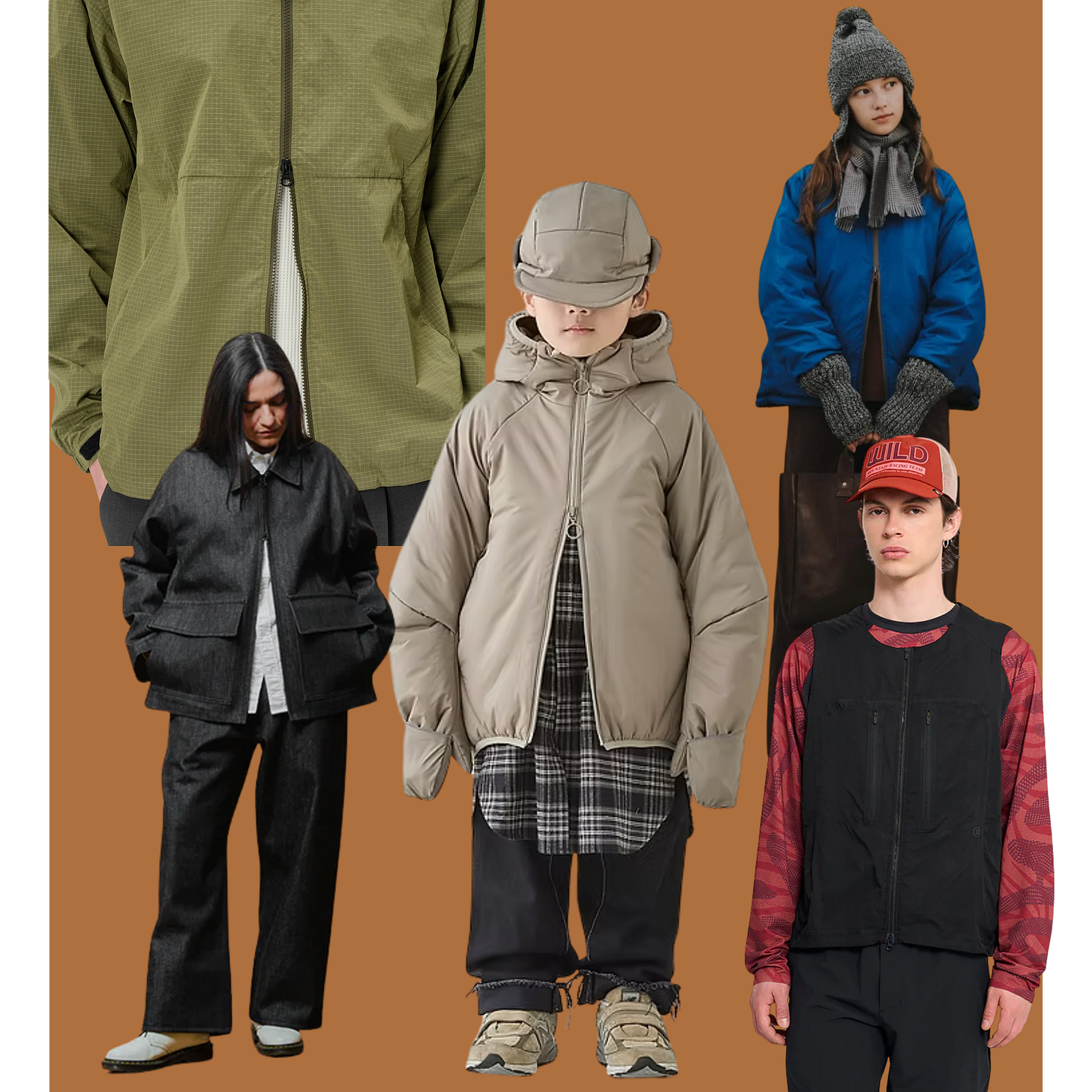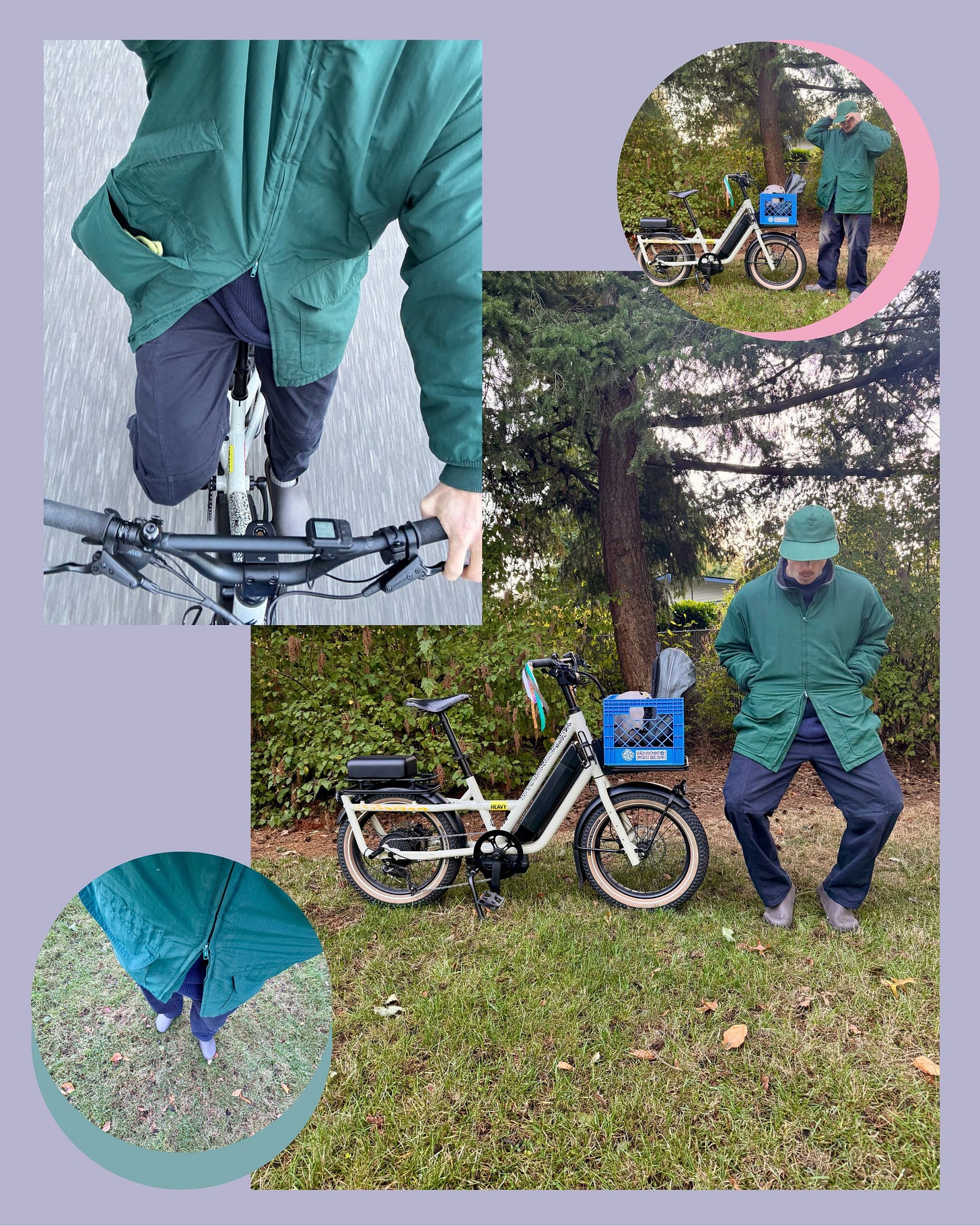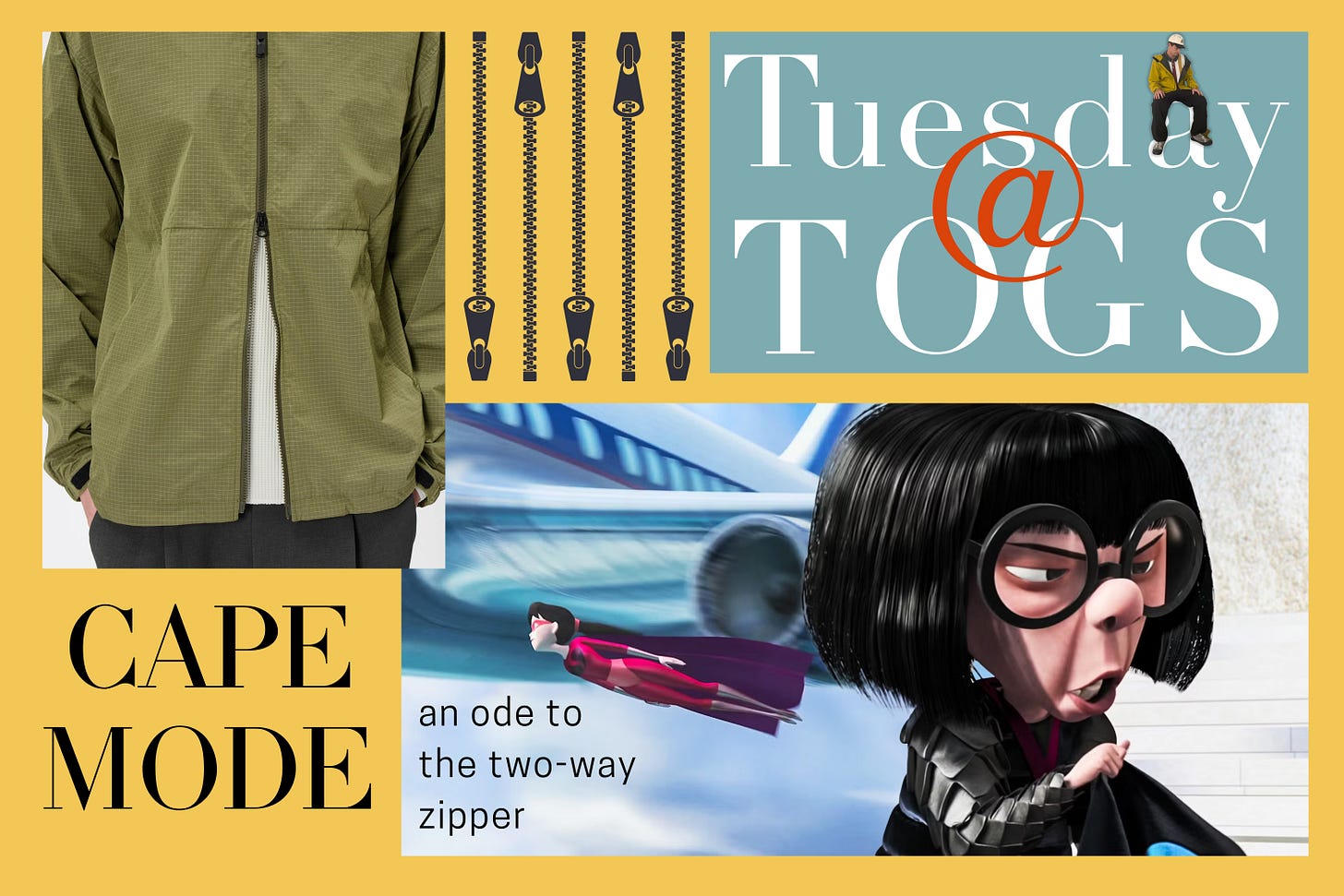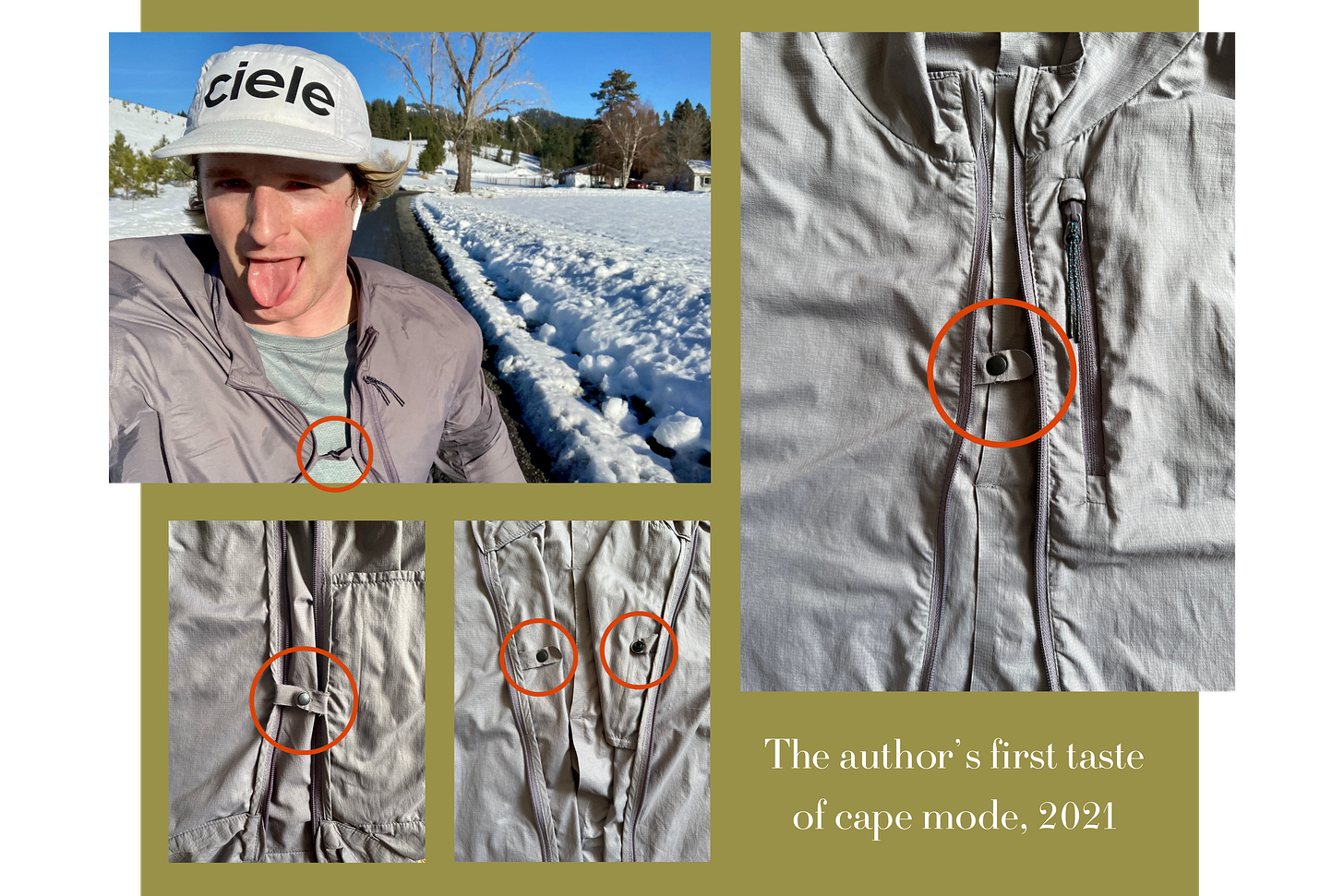CAPE MODE
an ode to the two-way zipper
Welcome to TOGS! Today is Tuesday, which means that this is neither Hadley nor Kellyn, but North, and you’re getting his twice-monthly, male-but-not-overly-masculine, missive on outdoor style. If North’s a stranger to you, you can read his introductory letter here and get yourself familiar 🤸🏼♂️
TOGS is a reader-supported publication, so consider becoming a subscriber to back our work and receive full access to all of our letters.
Hi hello,
It’s North again, and—in case you missed it—it’s also autumn. Prime time for some late-season alpine, by my lights, with the psychedelic greens of summer all cured to a russet palette that is at once more vivid and, somehow, more pellucid than the rest of the year, too. The world appears sharper, sounds crisper, and the air has a bit more wiggle room to it. Your sweat chills quickly and so do you, so it’s best to cozy up or keep moving.
I’ve been sporting in tee shirts and tank tops all summer, but now it’s time to start layering again—at least a little. For aerobic pursuits, fall can be challenging. What first feels like a cold morning can become downright balmy once your limbs start swinging and the sun gets to hitting. I hop into motion and say: too much. Or a breeze picks up and suddenly I think: not enough. Autumn is a time of inadvertent over-layering and under-layering. The sweet spot can be hard to find.

I like to go light, which this time of year means relying on one adaptable layer that can carry me through a variety of conditions. And today I would like to sing praises to the feature that ups the adaptability of any jacket: the two-way zipper.
EVERY JACKET HAS A ZIPPER: A SET-UP
Is it correct to say that almost every performance jacket has a zipper? And aside from anoraks, a full-length one at that. Zippers make jackets easier to put on, and they also add some ventilation value. (Duh.) But the standard top-down zipper presents somewhat of a problem. If you need to dump heat, you have two options: you can either let everything flap and fly free or you can go gourd form. Neither are ideal. Allow me to elaborate.
Historically speaking, letting things flap and fly free is steezy for some and impractical for most. When I think of open jackets, I think first of Phil Casabon skiing in Level 1’s 2009 movie, Refresh.
As teenagers, my little ski crew used to gin up some fun with what we called “Phil Casabon laps.” We’d unzip our coats like Phil did and let them billow behind us for a run or two. At speed or in the air, they were liable to slip off our shoulders. If we landed switch, they might flip inside-out over our heads. The challenge was to keep skiing like this didn’t hinder us at all. It did. Phil Casabon’s art was that his open jacket embellished his movements without obstructing them. Such is the skill that underlies steeze. I never quite got it, so letting everything flap and fly free is not, ultimately, for me.
I associate going gourd form with my father. Dads are world-renowned for getting hot and sweaty, so they’re a perfect demographic to look to when searching for ventilation tactics. Gourd form is the most basic move: just unzip your jacket from the top, but don’t do it all the way. The jacket will slouch open like a split gourd.
This approach succeeds in dumping heat but not in keeping your garment on your shoulders. Once you start moving, it also creates a pocket for air to catch in, puffing you up like a parachute. It’s not aero and also has a specific, hard-to-control effect on your overall silhouette. Thumbs down.
ENGAGING CAPE MODE: A FREEDOM
So, what’s a person who’s too warm to stay fully zipped, but not ready to fully de-layer, to do? The answer is to engage CAPE MODE.
The key to CAPE MODE is a two-way zipper. It’s as simple as that.
When you unzip from the bottom, you can open your jacket without loosening its grip across the chest and around the shoulders. Meanwhile, you begin to air out your belly and set the hem a’billowing.

Speaking practically, a two-way zipper on your shell has a variety of other benefits.
It gives you easier access to the hand pockets on your inner layers, which you can access by lifting your hem (as if raising a curtain) rather than by digging down from above (as if rooting through a sack).
If you’re a climber, a two-way zipper makes it easier to keep the area around your belay loop clear. (Arc’teryx, I’m told, has begun speccing two-ways on jackets people might wear belaying.)
If you do a sport where you frequently lean forward, like cycling, a two-way zipper lets you avoid any weird bunching by making the zipper length infinitely adjustable. (S/o to math.)
If your jacket is long and you pee standing upright, a two-way zipper clears the way.
Aesthetically, CAPE MODE adds dimension and intrigue while also enhancing the appearance of velocity. The body of your jacket whirls and whips behind you, but the rest stays put where it counts. It’s a hack that allows you to crib Phil’s steeze without much skill at all—and you can reap some performance benefits, too.
Perhaps Edna Mode, the famous designer from The Incredibles (2004), wouldn’t approve, but are we super in the same way that Elastigirl and Frozone are super? No, not really. My cape has never caught on anything of consequence, so I’m confident us civilians can rock CAPE MODE and feel super, safely.
DIY CAPE: AN OPPORTUNITY
If you don’t have a two-way zipper, you don’t necessarily have a problem. CAPE MODE works just as well with buttoned garments. For the crafty, it can also be attained with what seems to be a simple mod.
I got a grey Janji windbreaker years ago, before anything I owned had a two-way zipper. And instead of that—which, we must note, is often heavier and sometimes more finicky to zip than a one-way—it has two small button tabs sewn on the interior of its chest. You can unzip your jacket and snap those tabs together to create a cape.
As a solution, the snap tabs are more fiddly than two way zippers and also harder to engage while moving. However, they are pleasingly simple—and, for the sewists among us, something that could be tacked on to any existing jacket.
EVERYDAY SUPER
While practical for sporting, one can also play with subtler forms of CAPE MODE in everyday dress. At stasis, the effect is less dynamic than it is evocative. It’s a way to add dimension and evince layers, like cracking a door open on the otherwise enclosed room of your outfit, or parting the clouds on what otherwise might be the impenetrable grey dome of your jacket.
Speaking of the impenetrable grey dome of your jacket: this one I own from Goldwin has a clutch two-way zipper. Fully zipped, the jacket asks to be worn cinched up, Gen Z style—something I struggle to regularly commit to as a Zillenial. But unzipped from the bottom, the jacket relaxes a bit, begins to feel less monolith, and gains some dimension.

Two-ways have been specced on long jackets for a long time. I also like to wear this old fleece-lined J. Crew nylon coat that I pulled from my parents’ closet a decade ago. Initially—and sometimes still—I’d wear it to the start line of running races and then dump it before the gun went off for later retrieval. It’s long, warm, and non-precious, and so perfect for that purpose. But the jacket also has its own 1990s appeal, and you can cop one on eBay for about thirty bucks.

All this has made me a bit of a fiend for the two-way zipper. This fall, each time I’ve pulled a jacket out from its summer hibernation, I’ve hoped that I’d be surprised to discover one. Alas, most of them don’t have it. That’s okay, because ultimately this is not a make-or-break detail, but one that makes an already good jacket a little bit super.
Super, that is, or mysterious—my recent fixation on this detail has also turned up a bit of an enigma, so I’ll end by posting the following notice:

Any and all tips are appreciated. Reward is TBD.
Wheels up,
North 🤸🏼♂️🤸🏼♂️🤸🏼♂️






I love cape mode!
It says right there on the description! Versatility!